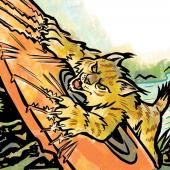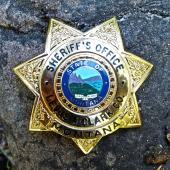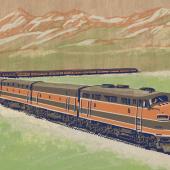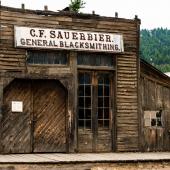The Sacred Tradition of the Sweat Lodge
In 1806 Private William Bratton of the Lewis & Clark expedition, a man of uncommon size and fortitude, fell ill. The ailment was mysterious, an unidentified affliction, which made it very difficult for him to walk, sit up straight, or perform his duties. As Bratton’s sickness became nearly impossible to bear, the crew attempted several laxative purges, most likely via the massive horse pills sent along with the expedition for just such an extremity.

Those pills, known by the Captains and crew members as “Thunderclappers”, were the invention of Dr. Benjamin Rush, one of the foremost American medical minds of the time. They produced the intended effect, but Bratton did not heal. His pains became worse, if anything. He could not stand, nor walk, nor paddle. Finally as the Corps rested at Camp Chopunnish, it was decided to try a Native American remedy.
Even Dr. Rush had to admit that one treatment in particular was very effective. An impromptu sweat was designed for Bratton, with a pit dug in the ground and filled with hot rocks, and a temporary enclosed shelter constructed around it. Bratton was set inside, and served a strong drought of Horse Mint tea, another piece of traditional knowledge purloined from the Native Americans. Within hours he felt better, and inside of two weeks it was declared that he was cured.
There is nothing so very surprising about that. Why shouldn’t a remedy and practice, which was nearly universal among the indigenous peoples of North and South America, prove an effective and useful one? From the Aztecs to the Innuit, sweat lodges were and are employed for their curative, therapeutic, and spiritual effects. And here in Montana, which enjoys a privileged relationship with its old ways, the traditional sweat lodge, as well as medical knowledge, is vividly alive.

More than 200 years after Bratton’s experience, two sweat lodges sit nestled into the hills of USDA land just outside of Bozeman. The spot overlooks the Missouri River basin, a confluence of waters that has always been sacred to Native Americans. At the bottom of the low hill sits the Lakota-Sioux lodge, and about 20 feet up the path is a Crow lodge. They look similar, although the Crow lodge opens to the east and is skirted by a fence. I am told by Crow lodge-keeper, Shayne Doyle, that this is because the Crow ceremony is performed nude, and the partition keeps the participants from prying eyes. He also hands me a tin can in which rattles some sage, which is thrown on the fire. On a bench lies a small wooden ladle for pouring water over the hot lava rocks. Lava rocks have been piled up further down the hill. Doyle tells me that sometimes members of other tribes will come and grab some for their own uses, in exchange for remembering the locals in their prayers. He tells me the Sweat Lodge ceremony is for the community.

Shayne Doyle holds a Masters Degree in Native American Studies and has many years of experience at teaching. He grew up on the Crow Reservation and has spent more than 25 years as a Plains Indian-style traditional singer and the keeper of a sweat lodge. His expertise on the subject is hard-won, since the only way to learn to keep a lodge is to learn it from someone else, who has learned it from someone else, so on. As an oral tradition Doyle estimates that it remains more or less unbroken since the first Paleoindians arrived on the continent 12,000 years ago.
Before I talked to Mr. Doyle, I was cautioned that “knowledge is not always viewed the way as you may be used to, such as in a school setting where you can just find it in a book, or go talk to someone who has the knowledge. One reason is because the ways are powerful and can come with risk and responsibility. For example, often when someone shows up to a sweat and they don’t know much about how information is received, they often ask a lot of questions about things... They don’t realize that someone has sacrificed a great deal to learn things. If you are going to approach someone like Doyle to ask him for information, it is best to present a sacred gift like some tobacco, which symbolizes your respect for the pains that person took in getting that knowledge himself.”

Mr. Doyle told me that the Crow sweats are segregated by sex, with the men bathing before the women. The Lakota sweat lodge has the rock pit in the center of the lodge, while the Crow have it offset, near the entrance. Some use sacred foods in the sweat, like fish or berries. Outside of Montana, and away from Plains Indians, the variations are even greater.
While the Crow tradition has been openly performed for decades, and a modern sweat lodge has been maintained on the site outside of Bozeman since the 1960s, some other tribes had to pursue the legal right to practice the sweat lodge, finally winning the right in the American Indian Freedom of Religion Act of 1978. Since then the sweat lodge has been practiced widely again by Native Americans and non-natives who seek something sacred, something restorative in the process.

Anyone interested in trying a sweat lodge experience is reminded to keep the ceremonial and spiritual component in mind. The sweat lodge is to be respected. It is also a balance of heat, water, and rocks, which must be maintained correctly, and it is not without danger. If someone in a ceremony put on by Mr. Doyle begins to get too hot, he says, they simply “say door and someone will open the flap, or else he can go outside. We are very careful to not make it too hot for newcomers, and to keep the rounds short. The bottom line is it should be used for healing. It is easy to disrespect.”
When performed properly in the traditional way Doyle says that “sometimes the rocks get really hot and start sizzling. The rocks, which we call the Grandfathers because they are so old, are talking to you. And the water and the heat are what cleanse you. With prayers, all these things combine to make a healing ceremony.”
At about sunset on a Wednesday afternoon, I arrive at the lodge too late to take part but just in time to find Shayne Doyle and some Native American friends toweling off after the last round of the sweat. I hear laughing and conversation as I approach. One of the men is a young Sioux, and says that this is his first sweat outside of his grandfather’s lodge. Another jokes that Packers fans sit on one side of the lodge, and the Viking fans on the other. “Let me put away my belly before you take my picture”, says a bigger man with a smile. There is something wonderful in this moment, a mix of the sacred and the new, but which confirms what Doyle had told me the day before: that the traditional sweat lodge, by being about healing, must necessarily be about community, too.

Yarrow (pic #4)
The Native Americans lived among a pharmacopeia of medicinal herbs, many of which are still used today. Among the more common to Montana is the wild licorice root. The plant was especially useful to Montana tribes, who recognized the roots of the plant’s value as a food source. In addition, the Blackfeet used it as a poultice for ear aches, while the Lakota chewed it to relief tooth pain. Even now it is a popular additive in cough syrups.
Yarrow, which grows on slopes and disturbed ground, was used variously to treat boils, burns, pimples and a variety of skin ailments as well as fevers, colds, and upset stomachs when taken internally as a tea.
The root which the Crow and many other Native tribes use in their sweat lodges is the Bear Root. When cut into pieces and thrown over the fire, it produces aromatic sparkles. It’s also used medicinally, as an infusion for bodily aches.












- Reply
Permalink